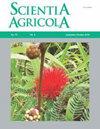Wort disinfection treatment with electron beam for bioethanol production
IF 2.6
3区 农林科学
Q1 Agricultural and Biological Sciences
引用次数: 2
Abstract
: Microbial contamination of the wort during the fermentation process causes significant losses in ethanol production worldwide and creates a dependence of the industry on chemicals and antibiotics to control contamination. Therefore, this study used electron beam (e-beam) to disinfect wort from sugarcane ( Saccharum officinarum L.) molasses and investigate the bioethanol fermentation. Four treatments (T0 – T3) were carried out using ionizing doses of radiation through the electron accelerator: 0 (control), 10, 20, and 40 kGy. Total mesophiles, total bacteria, sucrose, glucose, fructose, phenolics, flavonoids, hydroxymethylfurfural (5-HMF), and Furfural were measured. An alcoholic fermentation assay was performed after the irradiation process. The irradiated treatments showed no inversion of sugars and formation of the inhibitory by-products flavonoids, furfural and 5-HMF, except for the phenolic compounds. The lower dose tested (10 kGy) reduced more than 99.9 % of the total mesophiles and more than 99.99 % of the total bacteria in the substrate. In the fermentation, the irradiated worts presented similar ( p > 0.05) yields (92, 93, and 94 %) and ethanol productivity levels (0.89, 0.88, and 0.87 g L –1 h –1 , for T1, T2, and T3 respectively). However, all treatments presented higher yields and productivity ( p < 0.05) when compared to the control (88 % and 0.85 g L –1 h –1 ), highlighting the possible use of e-beam in wort fermentation at a lower dose (10 kGy). This allows reduction in losses caused by microbial contamination, besides increasing fermentation yield and productivity with lower energy consumption.生物乙醇生产中麦汁的电子束消毒处理
本文章由计算机程序翻译,如有差异,请以英文原文为准。
求助全文
约1分钟内获得全文
求助全文
来源期刊

Scientia Agricola
农林科学-农业综合
CiteScore
5.10
自引率
3.80%
发文量
78
审稿时长
18-36 weeks
期刊介绍:
Scientia Agricola is a journal of the University of São Paulo edited at the Luiz de Queiroz campus in Piracicaba, a city in São Paulo state, southeastern Brazil. Scientia Agricola publishes original articles which contribute to the advancement of the agricultural, environmental and biological sciences.
 求助内容:
求助内容: 应助结果提醒方式:
应助结果提醒方式:


